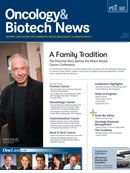Publication
Article
Oncology & Biotech News
Nonmalignant Late Effects Pose Heavy Burden After Hematopoietic Cell Transplant
Author(s):
The burden of late complications after hematopoietic cell transplantation is high, and these late effects are associated with poor health and decreased functional status.
Nandita Khera, MD
Investigators are reporting that the burden of late complications after hematopoietic cell transplantation (HCT) is high, and that these late effects are associated with poor health and decreased functional status.
The data are from a study that determined the prevalence of pretransplantation comorbidities and posttransplantation incidence of nonmalignant late effects that contribute to long-term mortality after HCT in a contemporary series of patients.
The results indicate that the changes in transplantation practices over the last decade have had a “variable” impact on the risk of complications after HCT, according to Nandita Khera, MD, with Fred Hutchinson Cancer Research Center in Seattle, Washington, and coworkers. In short, there has been a decrease in early transplantation-related morbidity without an appreciable decrease in late effects, which may be due to an increase in the median age of transplant recipients, the investigators said.
The study population included 1087 adults who underwent transplantation from January 2004 through June 2009 and who remained alive at least 1 year later.
The authors say that their study population “is reflective of transplantation practices introduced during the past decade, including the increased use of unrelated donors and mobilized blood cell grafts and the more frequent use of nonmyeloablative or reduced intensity conditioning regimens to enable HCT for older patients and those with comorbid medical conditions.”
Patients were followed for a median of 37 months after HCT, and medical records and yearly self-reported questionnaires were examined to determine if they had experienced any of 14 nonmalignant late effects.
The prevalence of preexisting conditions ranged from 0% to 7.5% in autologous survivors and 0.2% to 9.8% in allogeneic survivors.
The cumulative incidence of 1 or more nonmalignant late effects at 5 years after HCT was 44.8% in autologous recipients and 79% in allogeneic recipients. Overall, 25.5% of allogeneic and 2.5% of autologous recipients had 3 or more late effects.
The 4 most frequent late effects in the groups with 1, 2, or 3 or more late effects were similar and included thyroid disease, pulmonary disease, osteoporosis, and diabetes.
Notably, survivors with 3 or more late effects had lower physical functioning and Karnofsky score. They were also less likely to resume full-time work or study and more likely to be limited in their ability to perform routine activities.
Khera and colleagues said that their findings point to the need for additional research to reduce long-term morbidity after HCT or prevent it altogether. Potential interventions that might be examined at the time of HCT or in the post-HCT phase include modifications in transplantation techniques, improved supportive care, closer surveillance of high-risk patients, and better treatment if late effects develop.
Khera N, Storer B, Flowers ME, et al. Nonmalignant late effects and compromised functional status in survivors of hematopoietic cell transplantation [published online ahead of print December 5, 2011]. J Clin Oncol. 2012;30(1):71-77.










